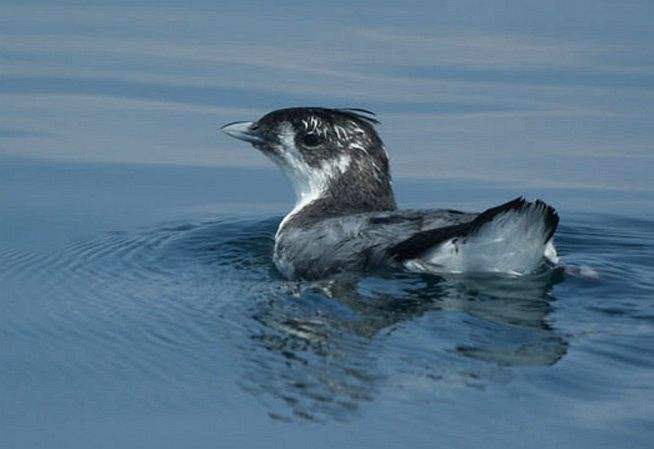Synthliboramphus wumizusume
IUCN
LCBasic Information
Scientific classification
- name:Synthliboramphus wumizusume
- Scientific Name:Synthliboramphus wumizusume,Japanese Murrelet, Crested Murrelet,Mérgulo japonés,Crested auklet
- Outline:Wading birds
- Family:Charadriformes Aukidae Platybill
Vital signs
- length:24-26cm
- Weight:150-210g
- lifetime:10-20 years or so
Feature
The cry sounded like a shrill whistle
Distribution and Habitat
Country of origin: Japan, Korea and Russian Federation (East Asia).
Wandering: The Chinese island of Taiwan.
It breeds in Japan's Izu Peninsula, Kamiko Motoshima, Izu Islands, Yamaguchi Prefecture, Fukuoka Prefecture and other coastal islands. Winter roams to Hokkaido, Kyushu, Okinawa, Korea and Sakhalin.
Marine bird with characteristics typical of small puffins. During the breeding period, it mainly inhabits the coast and coastal islands. It inhabits coastal waters during non-breeding periods.
Appearance
The small beak of the auk is very short and flat on the side, the forehead and the top of the head are black, and the cheeks and upper throat are gray. The dorsal, shoulder and upper wing coverts are dark gray, and the base and sides of the hind neck are dark dark brown, which is scattered with long white filaments, which are distributed up to the side of the neck. There are white stripes on the side of the superior head of the eye extending to the intersection of the superior occipital. The upper body is dark gray; The lower body is white; Dark brown on both sides. Crested only in summer and black pointed. In addition to the eye ring, the back of the head and the pillow are white, the whole head including the chin, throat and crown feathers and the back neck are black, and the crown is usually composed of 6-7 cm long narrow feathers; The winter feathers resemble the summer feathers, but the crown feathers are shorter, and the central part of the pillow and the nape of the neck are dar
Details
The Japanese Murrelet is a small seabird with characteristics typical of small puffins, without subspecies.

The crested flat-billed puffin is a rare stray bird and winter migratory bird in China. Often in small groups. Frequent surface swimming and diving. When in danger, they dive and flee. The sinking water is low. Clean the water before you dive. Flying low and straight, it falls to the surface soon after a short distance. It comes ashore in a roughly upright, penguin-like position, the result of convergent evolution. Good at swimming and diving, generally can dive more than 10 meters underwater. It feeds mainly on Marine animals and small fish. They hunt by swimming on the surface, and they hunt by diving.
The crested flat-billed puffin breeds on seabirds and coasts. Each brood lays 2 eggs, yolk brown or white, covered with gray or brown spots, the size of the eggs is 52-56 mm ×33.6-36 mm, average 53.37 mm ×35.05 mm.
Crested flat-billed puffins suffer from interactions with commerce and fisheries. Total species mortality from high seas drift-net fisheries is estimated to account for a significant proportion of the world total (Piatt and Gould 1994). At least 98 crested puffins were killed in 1990, and 40-160 May have died in 1991. The estimated annual mortality of adult birds in drift-nets (24-250) would be equivalent to 1-10.4% of the breeding population. The suspension of gillnet fishing in international waters in 1992 May have reduced the impact of netting, but gillnet fishing is still possible in Japan's 320 km exclusive economic zone (Piatt and Gould 1994).
Puffins are vulnerable to rat predation. In 1987, the remains of 145 crested flat-billed puffins were found on Koya Island, apparently killed by rats (Takeishi 1987, Ono 1993). The estimated total mortality was 414. Prior to rat eradication in 1987-1988, brown rats had entered some nesting colonies and nearly wiped out the population of crested flat-billed puffins. However, fisherman landings pose a constant threat of rat reintroduction, which was reintroduced in 2006, followed by a possible second eradication of crested platybill puffins. The species is also vulnerable to feline predation, and some communities are able to see exposed cats. Cats are believed to kill at least 30 birds a year on the South Korean island of Marado, a popular tourist attraction (S. Chan pers.comm). 2015). However, the presence of other predators on the island has been confirmed, so the deaths may not have been caused solely by the cats (K. Otsuki pers comm.2015).
Previously, oil spills have occurred in the range where crested flat-billed puffins live. The 1997 Nakhodka oil spill was one of the largest oil tanker spills off the coast of Japan, releasing nearly 6,200 kg of oil off the coast of Three Kingdoms (Akio Toyoda and Inagaki 2000). Regular exposure levels to offshore oil may make the threat persistent, but only to a few crested flat-bill puffins at a given time. The rapid population impact of the oil spill has not been recorded to date.
It was included in the List of Land Wild Animals under State Protection that are beneficial or have important economic and scientific research value (Item 215) issued by the State Forestry Administration of China on August 1, 2000.
Listed on the IUCN Red List of Threatened Species (IUCN) 2018 ver 3.1 - Vulnerable (VU).
Listed in China's National List of Wildlife under Key Protection (February 5, 2021) Level 2.
Protect wild animals and eliminate wild meat.
Maintaining ecological balance is everyone's responsibility!








